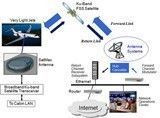
-
StatusOngoing
-
Status date2011-11-21
The objective of the project is to develop a low-profile hybrid mechanical-electronic steerable antenna allowing bi-directional high speed IP connectivity on board Light Jets through Ku-band SatCom systems. The activity will focus first on the design of core parts of the antenna and then on the manufacturing of a complete prototype that will demonstrate the capacity of the system. An overview of the antenna and of the system architecture is shown in Figure 1 below.
The antenna coupled with a suitable modem will enable high bit-rate communication from and to small aircrafts. The antenna will be suitable also for ground vehicles installation and potentially applicable to portable systems.
Figure 1 – Overview of the Communication system and of the Antenna structure.
The key issues addressed in this project are:
- Design of a single radiating aperture integrating transmit and receive functionalities and keeping the same performances as two separate apertures of the same diameter,
- Isolation of the receive and transmit amplification chains,
- Design of a low-profile rotating mechanical structure and RF transitions for simultaneous Tx and Rx operations,
- Minimisation of antenna thickness and diameter for reduced impact on aircraft aerodynamics.
The outcome of this activity will bring to the market a Ku-band antenna with a small thickness and size suitable for installation on small aircraft.
Thanks to the hybrid tracking system the antenna will have several competitive advantages like:
- Reduced drag due to a very small radome cross-section,
- Enhanced performances thanks to the special design of radiating elements allowing the use of the complete surface for both Tx and Rx functions,
- Increased MTBF thanks to the reduced mechanical movements,
- Reduced costs thanks to the electronic beam steering and polarisation tracking,
- Larger addressable market thanks to the reduced length of the antenna allowing installation on very small aircrafts.
The availability of this antenna in combination with a suitable Ku-band SatCom system will enable to offer broadband communications services with higher performances and lower costs with respect to existing L-band systems
The antenna aperture architecture is based on a circular low-profile structure with sub-arrays arranged in parallel rows.
Each row has a variable number of elements. The array rows are clipped within a circle in order to maximise the aperture efficiency within a given diameter. The antenna will be designed for linear polarisation with polarisation tracking, however the system re-configurability will allow also circular polarisation set-up. The rows are inclined to optimise the directivity and polarization quality in the typical direction of the satellite position. This architecture allows an advantageous allocation of space for the design of the feeding networks and integration of active elements for amplification and elevation beam steering.
The antenna will integrate two separate feed chains for transmit and receive functions, each one including respectively power and low-noise amplification as well phase control for elevation steering and polarisation tracking. The beam steering is based on a hybrid system. The antenna aperture is rotated mechanically in azimuth.
The antenna beam is steered electronically in elevation through the phase shifters integrated in each row of the antenna. The steering mechanisms are driven by a closed loop control system based on the level of the received signal. The steering control system is completed by the presence of inertial sensors, mounted in the rotating platform, providing information on the attitude, speed and acceleration of the antenna aperture. The contribution of the inertial systems will improve the stability of the reception for rapid accelerations.
The activity is composed of two main phases:
- Design and prototype of the radiating aperture:
- Review and completion of antenna requirements and specifications,
- Design of the radiating aperture,
- Manufacturing of a prototype and validation of aperture characteristic.
- Prototype of the complete antenna and system validation:
- Prototyping of the mechanical antenna platform,
- Validation of antenna performances in a typical satellite link.
The validation of critical breadboards to check the antenna design is ongoing.




